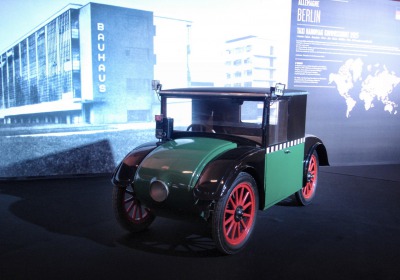Exhibition: Taxis of the World
Tue, 11 Nov 2008The 'Taxis du Monde' exhibit recently held at the Paris Motor Show displayed a total of 40 taxis from 20 cities around the world, illustrating the evolution and diverse needs of the past, the present and even the future.
Renault’s Type AG from 1913 is one historical example. One of the first Parisian taxis, it became known as the “Taxi of the Marne” after 1300 examples transported 6000 men to head off the German army in the first world war. On the other side of the spectrum is the PSA Future Taxi, an ordinary Peugeot Expert Tepee van laden with multi-media technology, including plasma screens and internet connectivity.
Other vehicles on display included the Volkswagen Beetle, which carries customers under the heat of the Mexico City sun; the Gaz Volga that shuttled people in Saint-Petersburg; and the Tuk Tuk from the streets of Bangkok, Thailand.
Fiat 600 Multipla
The first monospace was born from a constraint; to create a commercial vehicle from a rear-engined Fiat 600. To achieve this, the seats were moved to the top of the axle, which allowed seating for up to six people, while its large side door facilitated access. The Multipla appears ideal for transport in big cities such as Rome or Milan. Manufactured from the mid-1950s to the end of the following decade, it became a great success in the Italian market.
Checker - Model A11 Taxi Cab
Checker is the symbol of the New York taxi, immortalized in the 1976 cult film 'Taxi Driver' starring a young Robert DeNiro. The Checker imposed its 1950s style on the bitumen of Manhattan for nearly 50 years. Its form remained practically unchanged from the 1956 A8 model, save the addition of double headlights and ‘Federal bumpers' made from aluminum in 1973. The vehicles were often two-tone with a base of yellow, but in 1968 the law called for all New York taxis to be yellow.
Renault Project 900
Following the notion that a taxi needed better management of interior space, Renault's Project 900 was the avant-garde answer which never achieved success. Project 900 was created by Turin coachbuilder Ghia, who called into question common practice. It featured a very advanced light and roomy cockpit with a V8 engine in the back. However, two disadvantages prevented Project 900 from making its entry on the market: a trunk with difficult access - behind the back bench; and a certain feeling of insecurity for the driver and the front passengers due to the advanced forward position.
Hanomag Kommissbrot
The minimalist proposal of Hanomag for his 'Kommissbrot' illustrates Berlin in the 1920s, an environment which saw the Bauhaus movement in Germany emerge. Manufactured in Hanover, the Kommissbrot (so-called because its form alluded to the rye bread of the German army) could accommodate one passenger and applied the same tariff as motor bike taxis. At their beginnings, certain small Hanomag taxis covered up to 400km per day, even though they were devoid of heaters and unable to absorb bumps. The Kommissbrot taxi on display at the Salon is preserved at the Museum of the Techniques of Berlin, where it was restored.
Continues →
By Eric Gallina

